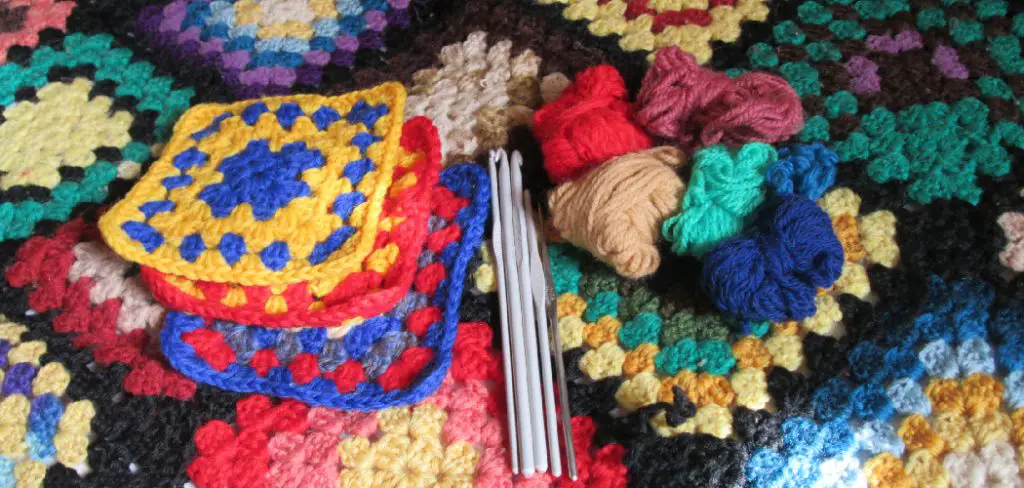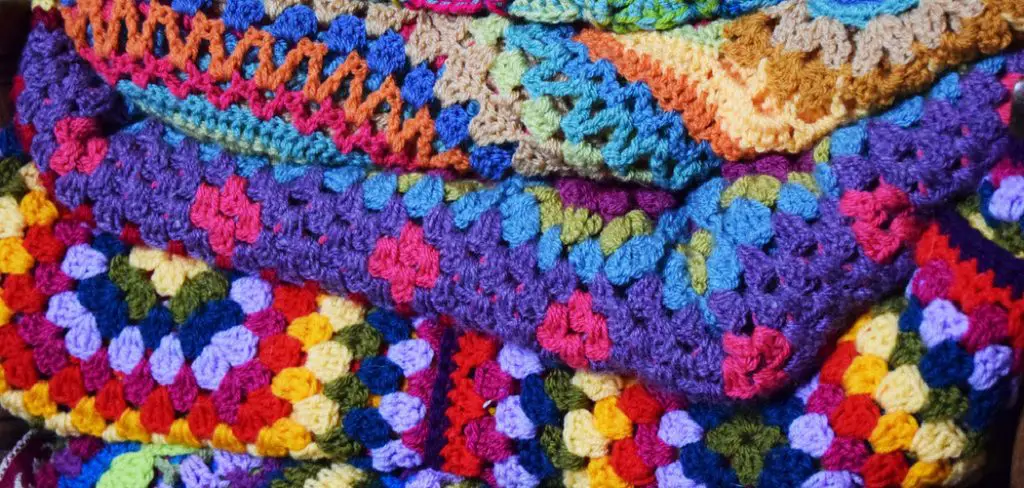Your crochet blanket is getting wider because you are unintentionally adding extra stitches as you crochet. A crochet blanket may start getting wider if you are inadvertently adding more stitches than required during the crocheting process.
This often happens when you accidentally insert your hook into spaces or loops where a stitch is not intended, resulting in the expansion of the blanket’s width. It is essential to pay attention to the stitch pattern, count your stitches regularly, and ensure that you insert your hook correctly to prevent any unintentional additions.
By being mindful of your crocheting technique, you can maintain the desired width and create a beautifully even blanket.

Understanding The Growth Of Crochet Blankets
Curious why your crochet blanket keeps getting wider? Discover the key factors behind its growth and find out how to understand and control this common issue.
As you spend hours diligently working on your crochet blanket project, you may notice that it seems to be getting wider. Understanding why this happens can help you navigate through the process and achieve the desired dimensions for your creation. In this article, we will explore the factors that contribute to the widening of crochet blankets and delve into the role of tension and stitch count, as well as the impact of blocking and yarn selection.
Factors Contributing To The Widening Of Crochet Blankets
Several factors can contribute to the widening of crochet blankets, resulting in changes to the dimensions you originally planned for. By being aware of these factors, you can take appropriate measures to maintain control over the final outcome of your project. The main factors to consider include:
- Tension and stitch count
- Blocking
- Yarn selection
Exploring The Role Of Tension And Stitch Count
The tension at which you crochet and the number of stitches you make per row play a significant role in determining the width of your blanket. If your tension is too loose, your stitches will be larger, causing the blanket to widen. On the other hand, if your tension is too tight, your stitches will be smaller, resulting in a narrower blanket.
To maintain consistent tension, it is important to pay attention to both your crochet hook and how tightly you pull your yarn. Experimenting with different hook sizes and adjusting your hand grip can help you find the right tension. Additionally, monitoring your stitch count, especially if you are using a pattern, is crucial. Any inconsistencies in stitch count can lead to uneven widening of your blanket.
The Impact Of Blocking And Yarn Selection
Blocking and yarn selection also play a significant role in the dimensions of your crochet blanket. Blocking refers to the process of shaping and stretching your finished piece to achieve uniformity. Depending on the blocking method you choose, it can either increase or decrease the width of your blanket slightly.
Furthermore, the type of yarn you select can impact the final dimensions of your crochet blanket. Different yarn fibers and weights have inherent characteristics that can cause variations in size. For instance, certain yarns may have more stretch or bulk, leading to increased or decreased width respectively.
Being aware of these factors and making adjustments along the way will help you maintain control over the size of your crochet blanket. By understanding the role of tension and stitch count, as well as the impact of blocking and yarn selection, you can confidently continue your crochet journey while ensuring your blanket meets your desired dimensions.
Common Mistakes That Cause Crochet Blankets To Widen
Common mistakes like using the wrong hook size and inconsistent tension can cause crochet blankets to widen beyond the desired dimensions. Pay attention to these factors to maintain the size and shape of your crochet blanket.
When creating a crochet blanket, it can be frustrating to see it widening unexpectedly. However, this common issue can be avoided by understanding the mistakes that can cause a crochet blanket to widen. In this section, we will discuss three key factors that contribute to this problem: insufficient tension control and inconsistent stitch size, incorrect crochet hook size, and yarn choice and its effect on growth.
Insufficient Tension Control And Inconsistent Stitch Size
One of the primary reasons why crochet blankets can widen is due to insufficient tension control and inconsistent stitch size. Tension control refers to how tightly or loosely you crochet your stitches. If your tension fluctuates throughout the project, it can result in stitches of different sizes, causing the blanket to widen unevenly.
Tip: To maintain consistent tension, practice keeping a steady grip on the yarn and ensuring your stitches are neither too tight nor too loose. This will help you create a fabric that maintains its intended measurements.
Incorrect Crochet Hook Size
The size of your crochet hook can also affect the width of your blanket. If you are using a hook that is smaller than recommended for your yarn weight, your stitches will be tighter and the blanket may start to widen. On the other hand, using a larger hook than recommended can lead to looser stitches, resulting in a wider blanket.
Tip: Always refer to the recommended hook size for your chosen yarn weight. Using the correct hook size will ensure that your stitches are consistent and prevent your blanket from widening unintentionally.
Yarn Choice And Its Effect On Growth
The type of yarn you choose for your crochet blanket can also impact its width. Certain yarns have a tendency to stretch or grow over time, leading to a wider final product. This is especially true for yarns with high elasticity or those that contain synthetic fibers.
| Yarn Choice Tips: |
|---|
| 1. Opt for yarns with minimal elasticity if you want to avoid excessive widening. |
| 2. Consider using natural fibers such as cotton or wool, which are less prone to stretching. |
| 3. If you prefer a certain yarn with higher elasticity, be sure to adjust your tension and hook size accordingly to compensate for potential widening. |
By being aware of these common mistakes and taking the necessary precautions, you can prevent your crochet blanket from widening beyond your desired measurements. Paying attention to tension control, using the correct hook size, and selecting suitable yarn will help you create a beautifully proportioned and completed blanket.
Preventing Unwanted Growth In Crochet Blankets
Prevent unwanted width expansion in your crochet blankets by adjusting your tension, using the right hook size, and counting stitches accurately. By following these tips, you can ensure that your crochet blanket stays the desired size throughout your project.
Maintaining Consistent Tension Throughout The Project
Consistency in tension is critical when it comes to preventing unwanted growth in crochet blankets. By maintaining an even tension throughout your project, you can ensure that each stitch is the same size, resulting in a more uniform and stable blanket. Although it may take some practice, it is essential to find a tension that works for you and stick to it. Keeping your stitches consistent will help prevent your blanket from getting wider unintentionally.
Choosing The Correct Crochet Hook Size
Selecting the right crochet hook size is another important factor in preventing unwanted growth in your crochet blanket. Using a hook that is too large for your yarn can result in looser stitches, causing your blanket to expand over time. Conversely, using a hook that is too small can make your stitches tighter, potentially distorting the overall shape of your blanket. To ensure optimal results, refer to the yarn label for recommended hook sizes and adjust accordingly based on your desired stitch tension.
Blocking Techniques To Control Growth
Blocking is a technique that can help control the growth of your crochet blanket. By wetting your completed blanket and shaping it to the desired measurements, blocking can help relax the fibers and encourage them to behave as intended. This can be particularly effective in reducing any unwanted stretching or widening that may have occurred during the crochet process. There are various blocking methods available, including steam blocking and wet blocking, each offering different levels of control over your blanket’s dimensions.
Tips For Selecting Yarn That Minimizes Stretching
Choosing the right yarn can also minimize stretching and prevent unwanted growth in your crochet blanket. Opt for yarns that have a good balance of strength and elasticity, such as those made with a blend of natural and synthetic fibers. Wool and acrylic blends, for example, offer durability and resilience, helping your blanket maintain its shape over time. Additionally, consider selecting yarns with a tighter twist, as this can contribute to a more stable and less stretch-prone finished project.

Frequently Asked Questions For Why Is My Crochet Blanket Getting Wider
Why Is My Crochet Blanket Getting Wider?
As you continue crocheting, your crochet blanket may naturally widen due to different tension levels while working on different rows. This can also be caused by the type of stitch used or changes in hook size. To prevent excessive widening, make sure to maintain consistent tension and use the same hook size throughout the project.
Conclusion
To wrap things up, if your crochet blanket is getting wider, don’t panic! It’s a common issue that can be easily resolved. Start by checking your tension and stitch count, as these factors greatly affect the width. Implementing proper blocking techniques can also help in keeping your blanket’s dimensions intact.
Remember to choose appropriate yarn and hook size for your project. With some patience and practice, you’ll be able to crochet a perfectly sized blanket that you can treasure for years to come.

